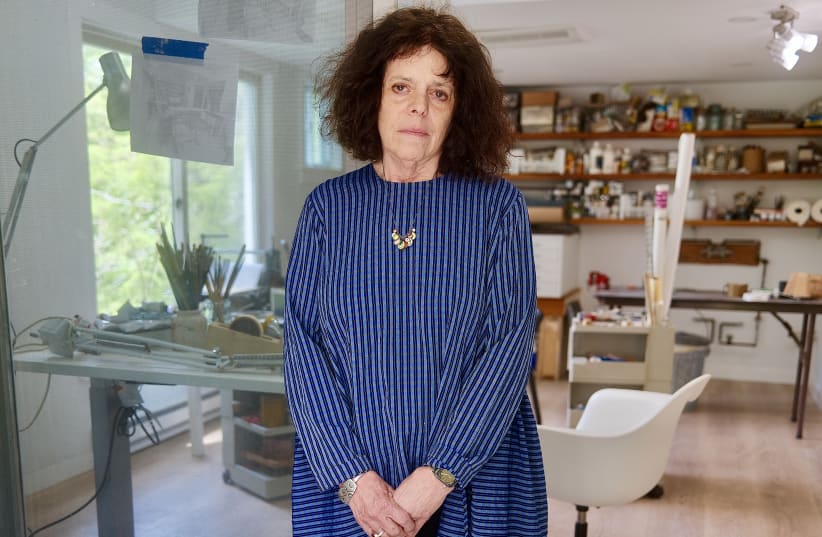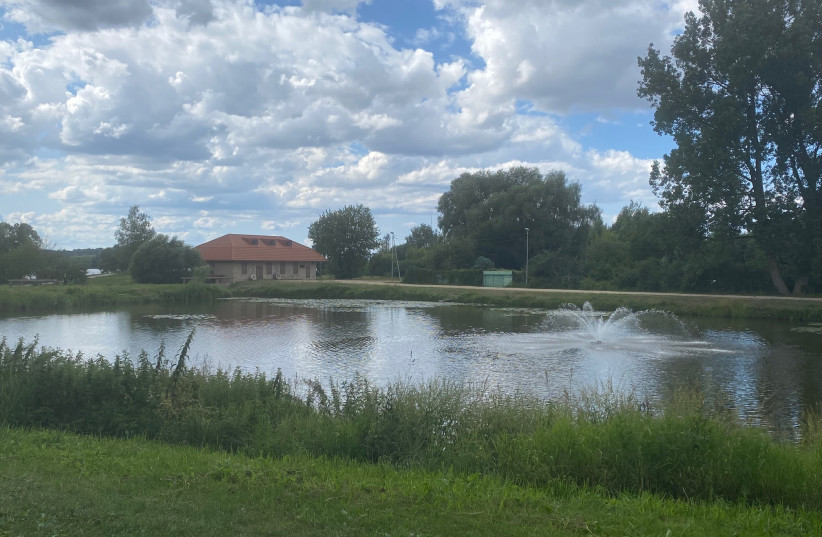(JTA) — Karen Frostig stood on a grassy patch of land near the Daugava River outside Riga in 2007 searching for a sign, a plaque, any marker acknowledging the thousands of Jews whom the Nazis murdered in and around the adjacent woods of towering fir trees over 60 years earlier, including her Austrian grandparents. There was nothing.
Instead, she walked past broken toilets, scraps of metal and bags of trash. The former site of Latvia’s Jungfernhof concentration camp was a dumping ground. Frostig, an artist and art professor at Boston’s Lesley University, had recently learned from archival documents that her grandparents, Moses Frostig and Beile Samuely, likely perished at Jungfernhof and not in the Riga ghetto as she long thought.
It was the end of March, and Frostig and her guide had bundled up in winter coats. “I was terrified to go there,” Frostig told the Jewish Telegraphic Agency. “I felt like I was walking into extreme danger. But then there was this magical experience. All of sudden we see these yellow butterflies, in winter. I felt this combination of fear and a spiritual journey of recovery. I knew I wanted to do a memorial of some sort.”
Getting recognition for the victims
Over the last 17 years, Frostig has worked with a dogged determination to recognize the victims of Jungfernhof, a camp that’s not extensively documented. Nearly 4,000 German and Austrian Jews died there, but few photos exist and any records were destroyed. Frostig has forged connections with survivors and descendants of victims worldwide, while spearheading an effort to install a memorial on site. Her project now has the support of Latvian officials.
Efforts are a critical step for Latvia, a country that’s only recently begun to grapple with the part it played in the Holocaust. Decades behind other European countries in restitution efforts for victims and heirs, the country only in 2022 allocated funds — $46 million — for the first time to reimburse the Jewish community for buildings the Nazis expropriated.
“Before, a prevailing opinion was that Latvian history and Jewish history were separate,” said Ilya Lensky, director at Riga’s Jews in Latvia museum. “Nobody would say anything like that today. That is very important progress.”
When she was growing up in Waltham, Massachusetts, Frostig’s father, Benjamin, who escaped Austria before the war, didn’t want to talk about his parents, though their passport photos hung on the living room wall. After art school, Frostig embarked on a career painting abstract images and worked in art therapy.
In 1991, she discovered a box in her mother’s basement containing documents detailing her father’s departure from Europe. Years later, she inherited letters he and his parents exchanged. Frostig had them translated into English. Soon after, she got Austrian citizenship. While in Vienna, it struck her that the city’s existing Holocaust memorials didn’t speak to her as a descendent. “They felt impersonal,” she said.
She went on to create a large-scale, interactive Holocaust-related memory project on the streets of Vienna. In 2013, Frostig’s “Vienna Project” marked the 75th anniversary of the Nazi’s takeover of Austria. It included 38 memory sites visitors learned about through an app, and projected the names of over 91,000 Austrian victims of National Socialism on the walls of the Austrian National Library and Hofburg Palace.
Then, Frostig once again set her sights on Latvia.
Memorialization efforts in Latvia ramped up after the country regained its independence from the Soviets in 1991. But Holocaust memory remains a work in progress, according to the Holocaust Remembrance Project, a 2019 report rating how European Union countries face up their Holocaust pasts. As in many post-Soviet countries, controversy remains around the scale of Latvian collaboration.
“Today, there is a much better Holocaust reconstruction infrastructure with museums and exhibitions,” said Peter Klein, author of the book “The ‘Final Solution’ in Riga” and dean of the master’s degree program in Holocaust communication and tolerance at Touro University Berlin. “With a Jungfernhof memorial, this would be a decisive step forward.”
Lensky said efforts were made in the 1990s to memorialize Jungfernhof, but consensus was the site was too remote. When Frostig returned with a memorial proposal three years after her initial visit, interest was lackluster.
In 2019, she went back. This time, officials were amenable and they asked that her plans start with a search for a mass grave containing hundreds of bodies described by eyewitnesses. Frostig got to work forming a team of historians and scientists and raising funds.
“Latvian society is a bit afraid of things parachuted in,” said Lensky, referring to local involvement from people living outside of Latvia. “But Karen has a great ability to bring people to her cause, including those who may not initially be interested.”
By this point, officials had transformed the land into a public park. Locals rollerbladed past a large fountain. There was a dog run, places to barbecue. A sign described the area’s history — since the 1700s it was a farming estate — and mentioned “a concentration camp, where German and Austrian Jews were imprisoned, who were performing agricultural work here.” There was nothing about their murders.
“I want there to be a permanent memorial at the park that speaks the truth about the history and what happened in this park,” Frostig told JTA.
Jungfernhof’s story starts in 1941. Frostig’s grandparents left Vienna for Latvia in December on Transport No. 13. That winter, Europe’s coldest on record, many of the Jews who arrived from Nuremberg, Hamburg, Stuttgart and Vienna died right away. Prisoners slept in stone buildings meant for animals with little light, no heat or water.
Jungfernhof survivor Alfred Winter wrote in his memoir that after the crops were planted, Kommandant Rudolf Seck remarked that “Dead Jews make good fertilizer.”
Fred Zeilberger, one of Jungfernhof’s 149 survivors, stacked fellow dead prisoners like firewood when they couldn’t be buried because the ground was frozen. He was 12. In the spring, the Germans buried the bodies and made Zeilberger plant potatoes on top.
Miles away in the Biķernieki forest, the Nazis shot “sardine-style” hundreds of mostly elderly Jews and children deemed not fit for work in what was known as the Dünamünde Aktion.
Zeilberger has been a faithful participant of monthly survivor and descendant Zoom meetings Frostig organized. “What Karen is doing is unbelievable,” he said. “She’s a go-getter.”
In the summer of 2021, Frostig’s team started work at Jungfernhof guided by a 1917 aerial map German pilots captured, 3D map models made by drones, and survivor testimony. Using ground penetrating radar and other geophysical techniques, they searched. The rabbi of Riga gave permission to take soil samples, a practice not typically permitted around Jewish graves.
“We’re looking for the hidden history,” said Philip Reeder, a geographer and cartographer at Duquesne University involved in the project. Reeder has worked on Holocaust sites across Eastern Europe, including in the Warsaw Ghetto. “There are lots more things that need to go in the history books,” he said.
A suspected trench discovered early on turned out to be the foundation of a former farm building. The team found tar, nails and animal bones. To date, they’ve surveyed around one acre of the five-acre site.
“We’re 100% sure there’s a mass grave there somewhere,” Reeder said. “All we can do is keep returning.” Finding the grave could protect it from future development. “Karen’s passion and enthusiasm for the project is infectious and uplifting,” added Reeder, who returns to Latvia this summer.
This spring Frostig organized an event at Brandeis University, where she is an affiliated scholar, to bring survivors and descendants together in person for the first time, a “Day of Remembrance” dedicated to developing community around memory.
The event opened with an immersive video installation of victims’ names scrolling against the backdrop of deportation videos to Latvia. Descendants, from their 20s to their 90s, pointed to ancestors’ names in the candlelit room.
“To see each other in person represented a special gift for us,” said Trish Acostas, whose mother, Joanna, survived Jungfernhof. Her grandparents died there. “It was restorative and clarifying. We’re learning how to talk about our experience as the next generation.”
On the event’s last day, Frostig unveiled a large-scale embroidered mourning shroud she created printed with victims’ names. Descendants carried it outside, laid it on soil from Jungfernhof Lensky brought, and said the Mourner’s Kaddish.
“Art is such an important part of how we remember,” Frostig said.
She hopes to bring an updated version of the shroud to Latvia, then include it in temporary museum exhibits telling the story of Jungfernhof. Before that, complicated questions need answering — where is the grave, what should a memorial look like, and how should a memorial operate in a recreational park? The local municipality will also need to grant permission.
Lensky said, “We will have a lot of discussions about what the memorial will be, but we will have it.”
Plans include installing an updated plaque this year that gives a fuller picture of the atrocities that occurred there. A groundbreaking ceremony for a memorial would, she hopes, follow in 2025, with descendants and survivors attending.
“It’s clear that memory is not one person,” said Frostig. “It’s a community. The meaning is when we come together.”

